| |
|
|
BLACK-FRONTED FORKTAIL
Ischnura
denticollis
|
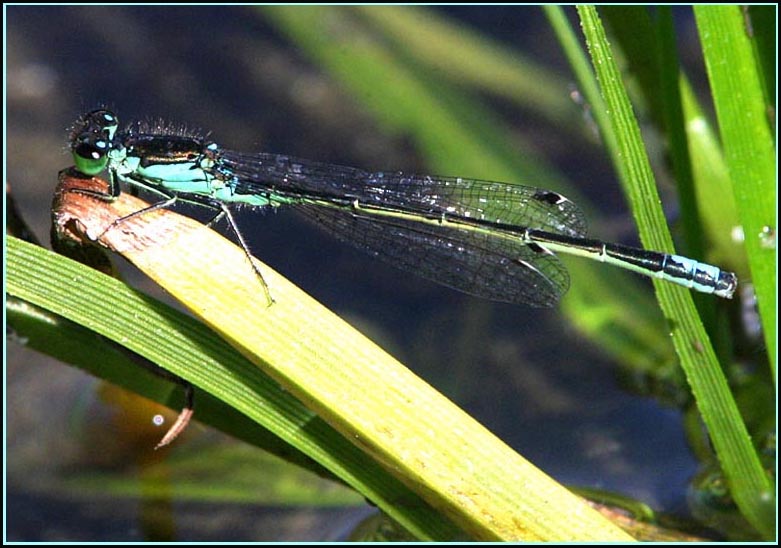
photo (above) 7
Oct 2006 Salinas River at
Salinas
Black-fronted Forktail is a very small and delicate forktail. It is a
weak
flyer and easily overlooked among low, emergent vegetation in shallow
water.
Yet, when found and viewed at close range, the male (above) is a
gorgeous
black-and-turquoise damselfly. |
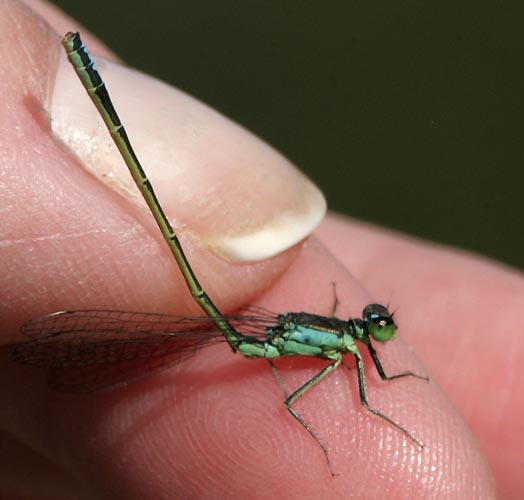 We
captured this particular male — the shot (below) shows it actual
life-size:
only 1 inch long. That should convince you just how tiny this ode
is. We
captured this particular male — the shot (below) shows it actual
life-size:
only 1 inch long. That should convince you just how tiny this ode
is.
Indeed,
Manolis (2003) says that "this is the smallest damselfly found in most
of California." But through a hand-lens — or, here, close-up
photography
(left) — many details can be observed.
Note that the black-and-torquoise includes the eyes (top half
black, lower
half aqua) and legs. |
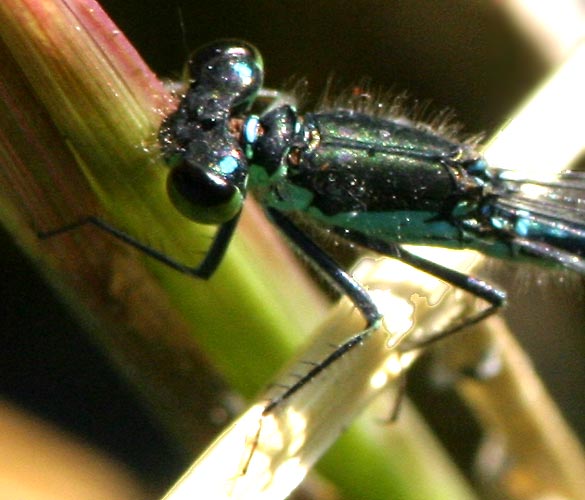 Close-up
notice the small blue spots adjacent to the eyes and the very
extensively
black upper surface to the thorax. This solid, iridescent pattern to
the
top of the thorax — without stripes or spots — is unlike any other
California
forktail . ... except one: San Francisco Forktail I. gemina. The latter
is so similar in pattern that it can only be identified by the male's
appendages.
Black-fronted and San Francisco Forktails hybridize where the ranges
meet.
There is now evidence that Black-fronted Forktail has 'swamped
out'
the more specialized San Francisco Forktail in the southern part of the
latter's former range. Specimens of San Francisco Forktail were
collected
on the Salinas River in 1946. It is now 50 years later and no I.
gemina
have been found in MTY for decades. They are also missing from their
former
range around the southern end of San Francisco Bay. Today, only
Black-fronteds
occur at these spots. Close-up
notice the small blue spots adjacent to the eyes and the very
extensively
black upper surface to the thorax. This solid, iridescent pattern to
the
top of the thorax — without stripes or spots — is unlike any other
California
forktail . ... except one: San Francisco Forktail I. gemina. The latter
is so similar in pattern that it can only be identified by the male's
appendages.
Black-fronted and San Francisco Forktails hybridize where the ranges
meet.
There is now evidence that Black-fronted Forktail has 'swamped
out'
the more specialized San Francisco Forktail in the southern part of the
latter's former range. Specimens of San Francisco Forktail were
collected
on the Salinas River in 1946. It is now 50 years later and no I.
gemina
have been found in MTY for decades. They are also missing from their
former
range around the southern end of San Francisco Bay. Today, only
Black-fronteds
occur at these spots.
Adult female Black-fronted Forktail (not shown)
are similar but not
as bright. The rich turquoise color of the male is replaced by paler
green
or tan. Immature females are orangey-tan.
all photos 7 Oct 2006 Salinas River at Salinas
|
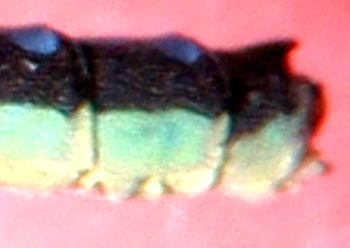 Here
(left) is an enlarged, close-up view of the male's appendages. The
prominent
black hook atop the 10th segment is not an appendage. Rather, the cerci
are the final blackish thin disc at the end of the segment. Below that,
note the paraproct: a pale (whitish) spur that extends the farthest to
the right of any portion of the segment. Male I. gemina lack this
projecting
spine at the lower edge of the inferior appendage. Here
(left) is an enlarged, close-up view of the male's appendages. The
prominent
black hook atop the 10th segment is not an appendage. Rather, the cerci
are the final blackish thin disc at the end of the segment. Below that,
note the paraproct: a pale (whitish) spur that extends the farthest to
the right of any portion of the segment. Male I. gemina lack this
projecting
spine at the lower edge of the inferior appendage. |
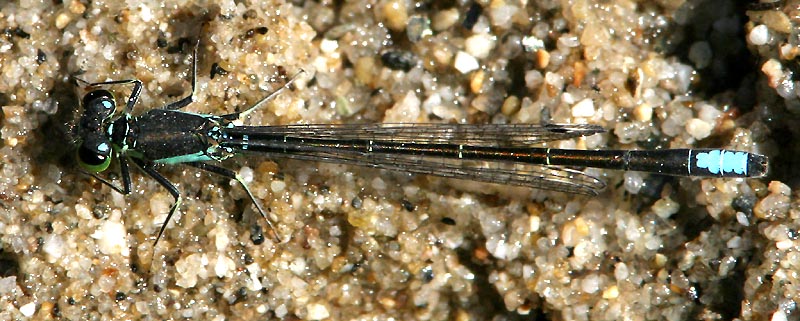
|
| Viewed from above, Black-fronted Forktail is
extensively black. Only
the tiny eyespots and the extensive turquoise blotch across the 8th
&
9th abdominal segments relieve the otherwise all-shiny-black
upperparts.
Given the tiny size of this insect, it almost 'disappears' into the wet
sand.
Black-fronted Forktail is widespread in
California. It frequents low
sedges and beds of grass near springs, small ponds, and "still
backwater
lagoons of rivers" (Manolis 2003). Dennis Paulson once stopped along
the
Salinas River, 5 miles south of San Ardo, back on 1 Sep 1977. He
collected
a pair of Black-fronted Forktail, and wrote in his notes: "very
abundant
in marsh, few at the river." Indeed, we located the one shown in these
photos on a little backwater side-branch of the Salinas River — well
away
from the strong currents in the main river. At the right date and in
the
right microhabitat, it can be a very common species.
|
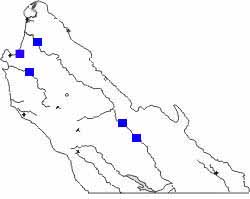 The
map shows the currently known MTY locations of Black-fronted Forktail.
Most are along either the Salinas or the Carmel rivers, although there
are records from Laguna Grande in Seaside. It likely
occurs at other locales which have the same shallow backwater habitat
of low grass or sedges. The
map shows the currently known MTY locations of Black-fronted Forktail.
Most are along either the Salinas or the Carmel rivers, although there
are records from Laguna Grande in Seaside. It likely
occurs at other locales which have the same shallow backwater habitat
of low grass or sedges.
Flight dates in MTY range from 12 March to 7
October.
Elsewhere in California
the flight dates range from March to November (Manolis 2003).
|
|
|
Literature cited:
- Manolis, T. 2003. Dragonflies and Damselflies of
California. Univ. of
Calif.
Press, Berkeley.
Web resources:
Major identification web sites with much information on California
odes include:
For sites with excellent photos to compare for identification or to
simply
enjoy, see:
Many of these sites have links to other useful pages. Kathy Biggs's
site
is particularly useful in her selection of links. |
|
All photos © Don Roberson 2007
TOP
|
|
|
|
|
|
|
|
|
